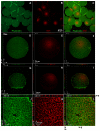Differential regulation of disheveled in a novel vegetal cortical domain in sea urchin eggs and embryos: implications for the localized activation of canonical Wnt signaling
- PMID: 24236196
- PMCID: PMC3827468
- DOI: 10.1371/journal.pone.0080693
Differential regulation of disheveled in a novel vegetal cortical domain in sea urchin eggs and embryos: implications for the localized activation of canonical Wnt signaling
Abstract
Pattern formation along the animal-vegetal (AV) axis in sea urchin embryos is initiated when canonical Wnt (cWnt) signaling is activated in vegetal blastomeres. The mechanisms that restrict cWnt signaling to vegetal blastomeres are not well understood, but there is increasing evidence that the egg's vegetal cortex plays a critical role in this process by mediating localized "activation" of Disheveled (Dsh). To investigate how Dsh activity is regulated along the AV axis, sea urchin-specific Dsh antibodies were used to examine expression, subcellular localization, and post-translational modification of Dsh during development. Dsh is broadly expressed during early sea urchin development, but immunolocalization studies revealed that this protein is enriched in a punctate pattern in a novel vegetal cortical domain (VCD) in the egg. Vegetal blastomeres inherit this VCD during embryogenesis, and at the 60-cell stage Dsh puncta are seen in all cells that display nuclear β-catenin. Analysis of Dsh post-translational modification using two-dimensional Western blot analysis revealed that compared to Dsh pools in the bulk cytoplasm, this protein is differentially modified in the VCD and in the 16-cell stage micromeres that partially inherit this domain. Dsh localization to the VCD is not directly affected by disruption of microfilaments and microtubules, but unexpectedly, microfilament disruption led to degradation of all the Dsh pools in unfertilized eggs over a period of incubation suggesting that microfilament integrity is required for maintaining Dsh stability. These results demonstrate that a pool of differentially modified Dsh in the VCD is selectively inherited by the vegetal blastomeres that activate cWnt signaling in early embryos, and suggests that this domain functions as a scaffold for localized Dsh activation. Localized cWnt activation regulates AV axis patterning in many metazoan embryos. Hence, it is possible that the VCD is an evolutionarily conserved cytoarchitectural domain that specifies the AV axis in metazoan ova.
Conflict of interest statement
Figures





Similar articles
-
The nanoscale organization of the Wnt signaling integrator Dishevelled in the vegetal cortex domain of an egg and early embryo.PLoS One. 2021 May 26;16(5):e0248197. doi: 10.1371/journal.pone.0248197. eCollection 2021. PLoS One. 2021. PMID: 34038442 Free PMC article.
-
Wnt signaling in the early sea urchin embryo.Methods Mol Biol. 2008;469:187-99. doi: 10.1007/978-1-60327-469-2_14. Methods Mol Biol. 2008. PMID: 19109711
-
Analysis of dishevelled localization and function in the early sea urchin embryo.Dev Biol. 2007 Jun 1;306(1):50-65. doi: 10.1016/j.ydbio.2007.02.041. Epub 2007 Mar 6. Dev Biol. 2007. PMID: 17433285 Free PMC article.
-
The emergence of pattern in embryogenesis: regulation of beta-catenin localization during early sea urchin development.Sci STKE. 2006 Nov 14;2006(361):pe48. doi: 10.1126/stke.3612006pe48. Sci STKE. 2006. PMID: 17106077 Review.
-
Visualizing egg and embryonic polarity.Methods Cell Biol. 2019;150:251-268. doi: 10.1016/bs.mcb.2019.01.001. Epub 2019 Feb 11. Methods Cell Biol. 2019. PMID: 30777179 Review.
Cited by
-
Polarized Dishevelled dissolution and reassembly drives embryonic axis specification in sea star oocytes.Curr Biol. 2021 Dec 20;31(24):5633-5641.e4. doi: 10.1016/j.cub.2021.10.022. Epub 2021 Nov 4. Curr Biol. 2021. PMID: 34739818 Free PMC article.
-
Generic Theoretical Models to Predict Division Patterns of Cleaving Embryos.Dev Cell. 2016 Dec 19;39(6):667-682. doi: 10.1016/j.devcel.2016.11.018. Dev Cell. 2016. PMID: 27997824 Free PMC article.
-
An early global role for Axin is required for correct patterning of the anterior-posterior axis in the sea urchin embryo.Development. 2021 Mar 31;148(7):dev191197. doi: 10.1242/dev.191197. Development. 2021. PMID: 33688076 Free PMC article.
-
A biphasic role of non-canonical Wnt16 signaling during early anterior-posterior patterning and morphogenesis of the sea urchin embryo.Development. 2019 Dec 16;146(24):dev168799. doi: 10.1242/dev.168799. Development. 2019. PMID: 31822478 Free PMC article.
-
Evolutionarily conserved Wnt/Sp5 signaling is critical for anterior-posterior axis patterning in sea urchin embryos.iScience. 2023 Dec 2;27(1):108616. doi: 10.1016/j.isci.2023.108616. eCollection 2024 Jan 19. iScience. 2023. PMID: 38179064 Free PMC article.
References
-
- Wilson EB (1925) The cell in development and heredity. New York: The Macmillan Press. 1232pp.
-
- Wourms JP (1987) Oogenesis In: Giese AC, Pearse JS, Pearse VB. Reproduction of marine invertebrates, Volume IX, General aspects: Seeking unity in diversity. Palo Alto: Blackwell Scientific Publications/Palo Alto: The Boxwood Press; pp. 50-157.
-
- Ke von Baer (1834) Die metamorphose des eies der batrachier vor der erscheinung des embryo. Arch Anat Physiol Wiss Med 1: 481-509.
Publication types
MeSH terms
Substances
LinkOut - more resources
Full Text Sources
Other Literature Sources
Miscellaneous

